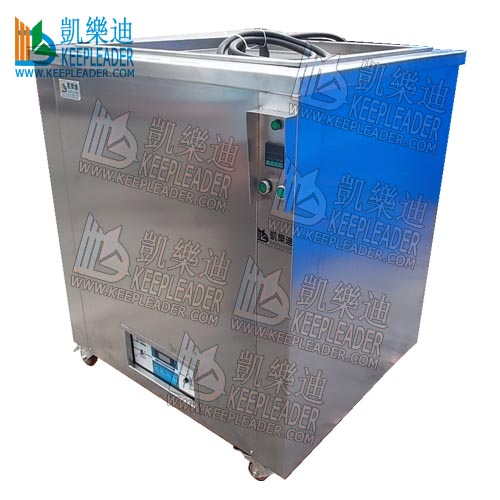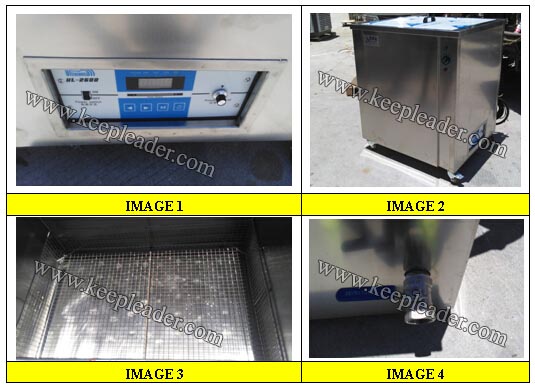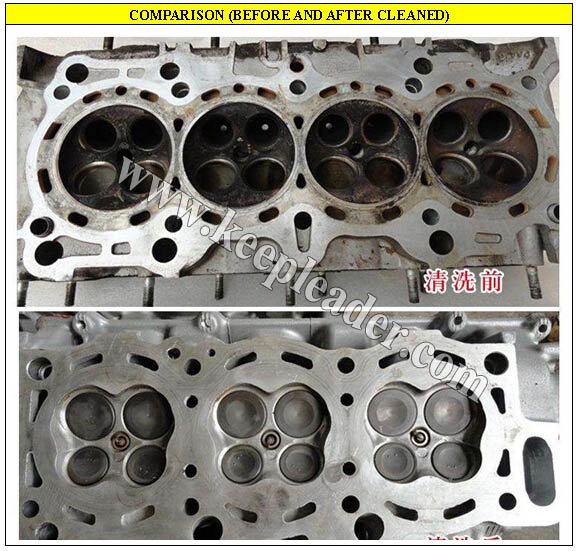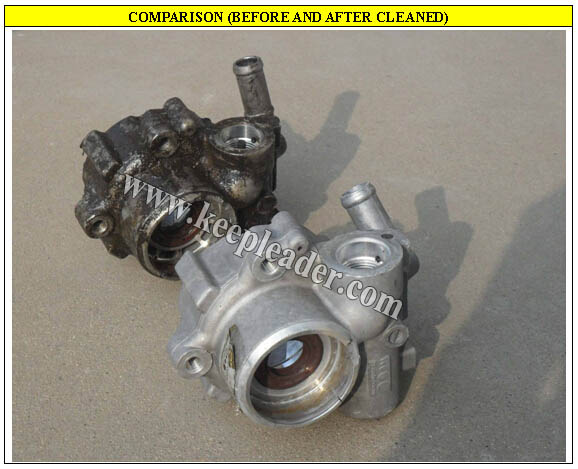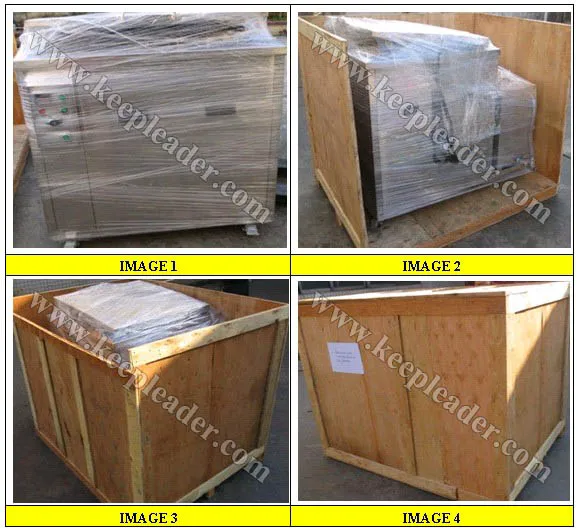Truck Parts Ultrasonic Cleaning Machine for Auto_Engine_Car_Aviation_Motor_Hardware Parts Cleaning Ultrasonic Cleaner Degreasing
Truck Parts Ultrasonic Cleaning Machine for Engine parts Ultrasonic Cleaning
Truck Parts Ultrasonic Cleaning Machine is single tank of ultrasonic agitation aqueous cleaning device for Car parts, truck parts, aviation, automotive, pharmaceutical, electronic components degreasing
Application | ||
Truck Parts Ultrasonic Cleaning Machine Does Cleaning for Motor, Car engine and peripheral engine parts, and other metal parts in need of removeing oil, Polishing wax, dust and etc | ||
Character | ||
Auto frequency tracking function, which have advantage of automatic find the best ultrasonic performance for different cleaning parts This machine can connect with remote control All in one machine, Compacted design, which is easy operation The machine has special access to do maintenance Low voltage operation penal for safe operation | ||
Detailed parameter | ||
Name | ||
Model | KLE-1048 | |
Vibrators | 48pcs | |
Auxiliary | cleaning basket and heating | |
Ultrasonic power | 2.9KW | |
Heating power | 8KW | |
Vibrator standard | 28khz/40khz,50W/60w/pc (optional) | |
Power supply | 380V/220V,50HZ/60HZ (optional) | |
Size of inner cleaning tank | 800*650*650mm(L*W*H) | |
Size of outside | 1000*850*1300mm | |
Capacity | 338L (270L is available) | |
Control mode | Mechanical | |
Heating temperature | 0 up to 110 adjustable | |
Vibration mode | Bottom vibration | |
Heating mode | Heating board at two sides | |
Cleaning basket | Stainless steel, the mesh over 10*10mm | |
Switch | Separated Power Switch, Ultrasonic SW and Heating SW | |
Configuration | ||
Assembled Four Universal wheel | ||
Separated lid/Cap | ||
With cleaning Basket | ||
Each generator has power wire of 5m | ||
High Q value(NTK made in Japan) Vibrators | ||
Stainless steel Drain valve assembled under the bottom | ||
Automatic frequency tracking Generator | ||
Over-current protection | ||
Soft-start function | ||
Material | ||
Inner cleaning tank | SUS304L,2.0mm | |
Vibrating side | SUS 304L,2.5mm | |
Surrounded outside | SUS 304L,1.0mm | |
Base support | Stainless steel Square tube 38mmx38mm,1.5mm | |
DC Connector | no, low voltage power connection | |
Process standard | ||
Vibration side | Hard chrome plated over 0.05mm | |
Appearance | No glitches, no corners, smooth, beautiful | |
Inner cleaning tank | Well welded, upright, water-proof | |
Welding spot | No burn marks, welding marks after polishing | |
Fixed screw | Ball head smooth | |
Assembled mode of vibrator | Glued + Screwed | |
Heating rod | Well insulated, short-cut protected | |
Free spare parts | ||
Separated generator, heating rod, fuse | ||
Packing | ||
Wooden case with pallet, easy operated by fork Supported under the bottom avoid impacting during delivery Stretch seal around | ||
Detailed iamges
Truck Parts Ultrasonic Cleaning Machine has ♦1: Single tank ♦2: Cleaning basket ♦3: Tank lid ♦4: Heating ♦5: Dirty Drainage valve ♦6: Casters
Buying guides
BUYING GUIDANCE
01: Choose your correct system
For customers demanding multiple stage ultrasonic cleaning and high efficiency parts drying, KEEPLEADER™ multi-stage consoles provide the same efficient, effective ultrasonic cleaning technology plus the ability to move the items items through additional wash and rise stages, KEEPLEADER™ will design a custom-sized and custom-featured ultrasonic cleaning machine to meet your specific needs
011: heated ultrasonic cleaning
012: heated ultrasonic cleaning + heated rinse
013: heated ultrasonic cleaning + heated ultrasonic rinsing
014: heated ultrasonic cleaning + heated ultrasonic rinsing + hot air drying
015: Inner size of cleaning tank, frame construction, custom color, ultrasonic frequency
02: Choose your tank size
021: the length*Width*depth you wanting
022: advise KEEPLEADER™ the size of your cleaning parts and cleaning efficiency
03: Each system includes:
031: Full insulated stainless steel tanks
032: Exterior power coat finish
033: Digital temperature controls-each tank
034: Digital timer-controlled ultrasonic cleaning
035: Dual stage filtration-cleaning stage
036: Single-stage filtration rinse stage
037: Low-level float sensors-each stage
04: Exceed industry standards
041: All size available, including bench version
042: High quality stainless steel construction
043: For vapor degreasing, cleaning and drying applications
044: Full solution control features
Cleaning effect
Truck Parts Ultrasonic Cleaning Machine can clean enginer bolck assembled or small metal components
Packaging and shipment
For "Truck Parts Ultrasonic Cleaning Machine" we adopt plywood case both sea freight and air freight
FRQ
What are ultrasonic waves of ultrasonic cleaning?
Ultrasonic waves are sound waves transmitted above 20khz, or higher that the frequency detectable by humans, sounds waves are created by the vibration of an object, which causes the air molecules around it to vibrate, these vibrations cause our eardrums to vibrate, which the brains then interprets as sound when the original vibration is very fast, so the sound waves, and the pitch of the sound created is too high for the human ear to hear
In the natural world, animals like dolphins and bats are use these ultrasonic waves to communicate, but humans have discovered practical application, the most commonly known is medical ultrasonography although in the last 30 years, some organizations have discovered highly effective, chemical-free cleaning applications and technology, ultrasonic cleaning machines work in a vey similar way to a loud speaker, except the ultrasonic waves travel at a much higher frequency and through water instead of air, a high-frequency electronic generator that creates ultrasonic waves is connected to a diaphragm, a flat or cone-shaped structure similar to the visible cone-shaped portion of a loudspeaker, that generator vibrates the diaphragm at a specific high frequency, usually between 25 and 170khz, inside a specially designed water tank, the ultrasonic waves created cause the water molecules to vibrate rapidly, creating alternating waves of compression and expansion within the water, during the expansion phase, or rarefaction cycle, the liquid is torn apart, creating cavitations bubbles, these bubbles are where ultrasonic cleaning technology is born
How does ultrasonic cleaning machine work?
Cavitations bubbles are vacuum cavities as tiny as red blood cell, or about 8 thousands of a millimeter across, they are so small that it would take 1250 of them lined up in a row to reach 1cm long
Under pressure of continuous vibration, these bubbles stretch and compress at a fast rate, once they reach a certain size, as determined by the frequency and stretch of the sound waves produces, the bubbles lose structural integrity and collapse violently, when these implosions happen near a surface, the bubbles emit high-powered steams of plasma that travel at more that 500 miles per hours and collide with, agitate and remove even very tiny particles and substances from that surface
In an ultrasonic cleaning machine, this happens millions of times per second, but because cavitations bubbles are so small, the process is both highly effective and very gentle, ultrasonic technology can be clean metals, plastics, glass, rubber and ceramics, it effectively removes a wide variety of contaminants, even if present only in trace amounts, including dust, dirty, rust, oil, grease, soot, mold, carbon deposits, polishing compounds, was, pigments, lime scale, bacteria, algae, fungus, fingerprints and biological soil
These contaminants typically are removed even if they are tightly adhered to or embedded onto solid surfaces, or if they are in remote cracks or tiny crevices of an object. For this reason, items usually do not need to be disassembled before being put safely in an ultrasonic cleaning unit
Cleaning solution?
As ultrasonic cleaning technology was developed, it was discovered that if surface tension is reduced, cavitations levels increase, cleaning solutions used with ultrasonic cleaning machines
Contain ingredients specially designed to increase the effectiveness of the process. These are called surfactants and they lower the surface tension of water.
General-use soap solutions: these solutions have a high alkaline content and are designed to remove a number of contaminants from metals, plastics and fabrics, depending on their formulation, soap-based metal cleaners will remove oil, grease, and carbon deposits, those formulated for use with plastic and fabric items won’t clean oil-based deposit from these materials
Descaling detergents: are formulated to clean metals laden with corrosion, rust, hard mineral deposits or heat scale. They are designed to help restore parts that have been in service in hard water or high-humidity environments. These solutions are acidic in nature.
Enzyme detergents: Enzymes are used to degrease stainless steel, aluminum, brass and titanium parts, and ca be more effective that general-use soaps when removing oil and grease, they are designed to clean heavily oiled surfaces when an oil-free environment is preferred or required, they also can be used effectively to remove biological contaminants from medical, surgical, dental, and optical tools, enzymes typically consume oil residue and digest it off as carbon dioxide
How Ph cleaners: come in number of formulations and can be helpful in several ultrasonic cleaning application, and protect metals from the effects of chemicals, some of the stronger how pH cleaners many damage certain materials, specifically aluminum, copper, and brass, citric acid solutions are used to passivate stainless steel and titanium by removing the free iron molecules from the surface of the metal to help prevent future corrosion such as rust
Specialty detergents: some solutions are formulated to clean specific contaminations like smoke, soot and certain odors, although these specialty detergents will work very effectively when used in certain application, they can be harmful or ineffective when used outside of their intended use
Some solutions are formulated to clean specific contaminants like smoke, soot and certain odors. Although these specialty detergents will work very effectively when used in certain application, they can be harmful or ineffective when used outside of their intended use.
What should consider on longevity?
Some solutions have a longer lifespan that others, which helps decrease long-term cost, but all solutions have their pros and cons, for example, when removing oil and coolants, users must choose between using an emulsifier solution or separating detergent, and emulsifier holds oil in suspension with in fluid, so it does not last as long, once the solution is saturated with oil, it is no longer effective, a separator can remain effective for up to three months or longer, however, it cleans less effectively and, since oil rises to the surface of the tank, users risk recontaminations during item removal unless filtration systems-overflow weirs or surface spargers-are added to the unit
What should consider on solution disposal?
Most ultrasonic cleaning baths are environmentally friendly and water-based, but depending on the solution used and contaminant removed, various methods of waste disposal may be required, most ultrasonic cleaning baths are 92 percent water and wastewater evaporators will reduce the amount of material required disposal by that amount, these solutions also often can be effectively neutralized or filtered until it can be released into the sewer system safely and legally
Is heating should be considered in solution cleaning?
Solution are often used in combination with heat, which effectively eliminate entrapped air in the water tank, for most applications, a temperature of 50 to 65 degree is effective, however, for some medical applications it is generally accepted that solutions should be used at temperature below 38 degree to prevent protein coagulation
Contact Us
☺ Attn:Ms Helen
✉ E-mail:sales@keepleader.com
☎ Cellphone:+86 13590415784 (Wechat/Whatsapp)
☎ Tel: +86 755 84190358
☞ Website: www.hfwelds.com / www.keepleader.com
Products
Search
ContactUs
ADD: Rongxing Bldg, Bulong rd, Bantian st, Longgang, Shenzhen 518129 P.R.China
ZIP: 518129
Contact: Ms Wang
Tel: +86-755-84190358
Fax: +86-755-84190358
Mob: +86-13590415784
Email: sales@keepleader.com

Welcome to visit our Factory!!!
Copyright ©2004-2025 ultrasonic cleaner,ultrasonic welder,high frequency welder,Ultrasonic golf Cleaner,High frequency packing machine,Vapor degreaser,Transparent Cylinder making machine,portable spot welders All Rights Reserved.
ADD: Rongxing Bldg, Bulong rd, Bantian st, Longgang, Shenzhen 518129 P.R.China ZIP: 518129 Contact: Ms Wang
Tel: +86-755-84190358 Fax: +86-755-84190358 Mob: +86-13590415784
Email: sales@keepleader.com 技术支持: keepleader


